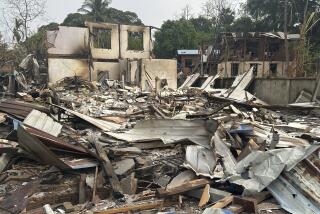The numbers prove it -- Iraq’s a civil war
- Share via
SO IS IT A CIVIL WAR in Iraq or isn’t it? By the straightforward definition — a war fought between factions or regions within a single nation — the answer seems clearly to be yes. That’s why NBC and the Los Angeles Times recently decided to use the phrase to describe the ongoing sectarian conflict. It’s a “fairly simple call,” said the foreign editor of The Times.
But not everybody agrees. Official news releases, media reports, politicians and generals still talk of Iraq “on the brink” or “teetering on the edge.” Full-scale civil war, according to these accounts, is “threatening” or “looming” or “menacing.” It’s a question of definitions, said a Pentagon reporter recently. According to U.N. Secretary-General Kofi Annan: “We are almost there.”
I would argue, however, that by one very basic measure — the number of Iraqis killing each other — we’ve been there for a while, and that there’s no more defining left to be done. Simply compare the grisly statistics in Iraq with figures from other conflicts that already have been certified as genuine, full-scale civil wars. Then try to argue that this isn’t one. It’s a difficult case to make.
Of course, there’s no way one can exactly measure one “civil war” against another. Each has unique ethnic, religious and political passions fueling the particular savagery. Nor is it easy to obtain accurate casualty figures, much less comparable ones, across the years and around the world.
A study published in the Lancet last month, for example, concluded that about 650,000 Iraqis had died by violence since March 2003. But that report has been widely criticized, so let’s take instead the report just issued by the United Nations, which said that 3,709 Iraqis were killed in October.
Those figures are based on statistics from the Baghdad morgue and hospitals and other morgues across the country, and overwhelmingly reflect killings carried out by Iraqis against Iraqis. Many observers believe that the actual tolls are much higher because the bodies of many of those killed never make it to hospitals or morgues, but the U.N. figure (the fourth straight month in which the number is more than 3,000) may be the best estimate we can get.
Now take the American Civil War, the tragic internecine conflict that devastated the U.S. from 1861 to 1865. Estimates of the number of soldiers and civilians who died vary widely, but the figure most often cited (by historian James M. McPherson, among others) is about 618,000 — a toll that exceeds the number of Americans killed in all its other wars, from the Revolutionary War through Vietnam.
In fact, though, sickness, disease and other non-battlefield factors caused 414,000 of those deaths. The number of Americans actually killed by other Americans was 204,000. Because the war went on for 48 months, that works out to 4,250 killings a month — not so many more than are dying in Iraq today.
What’s more, Iraq’s population today is about 25 million, or about 80% of the U.S. population in 1860. So, on a per capita basis, the monthly rate of killing during the U.S. Civil War would be the equivalent of 3,400 Iraqis being slaughtered each month — also well under the 3,709 killings that Iraq experienced in October. Admittedly, Iraqis haven’t been murdering each other at American Civil War rates since the war began, but they have been doing so at least since the summer, and the deadly tempo keeps increasing. November’s fatalities threaten to be even higher.
Iraq’s monthly body count also has surpassed the awful statistics from the civil war that ravaged Lebanon from 1975 to 1990. That war resulted in about 100,000 deaths, according to Dilip Hiro in his “Lebanon — Fire and Embers: A History of the Lebanese Civil War.” On a per capita basis, the equivalent number for Lebanon would be 3,330 a month, also well under Iraq’s current rate.
Certainly Iraq’s killing rate is nothing like the horrific genocide in Rwanda in 1994, when up to 800,000 Tutsis and moderate Hutus were slaughtered in three months of genocide. Nor does it compare with the ghastly violence that convulsed the Democratic Republic of Congo beginning in 1998, in which an estimated 3.8 million people died.
The Spanish Civil War (from July 1936 to April 1939) also has a well-deserved reputation for vicious bloodletting. Estimates of the number of deaths from all causes range widely. But if we take the figure of 250,000 used by the BBC, the number of people who died works out to about 7,575 a month — roughly twice that of Iraq today.
But, at the rate things are spiraling out of control in Iraq, those differences could be erased.
More to Read
Sign up for Essential California
The most important California stories and recommendations in your inbox every morning.
You may occasionally receive promotional content from the Los Angeles Times.










